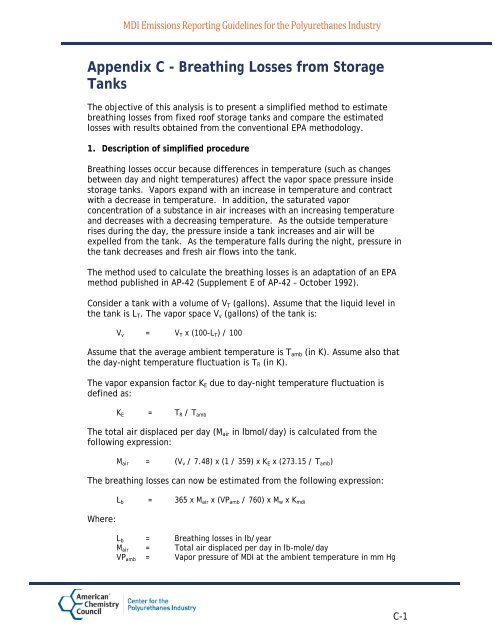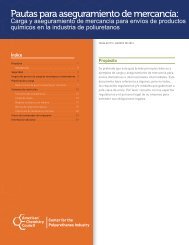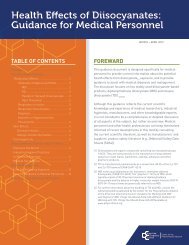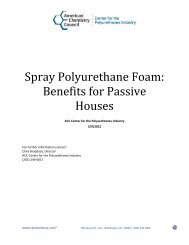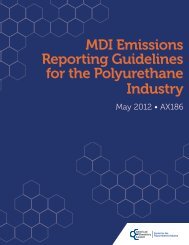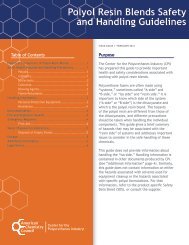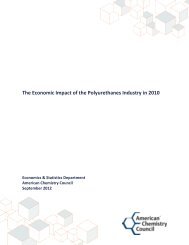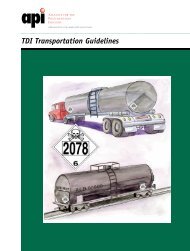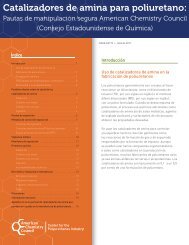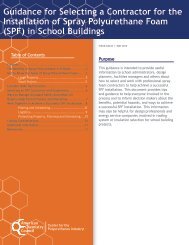MDI Emissions Reporting Guidelines for the ... - Polyurethanes
MDI Emissions Reporting Guidelines for the ... - Polyurethanes
MDI Emissions Reporting Guidelines for the ... - Polyurethanes
You also want an ePaper? Increase the reach of your titles
YUMPU automatically turns print PDFs into web optimized ePapers that Google loves.
<strong>MDI</strong> <strong>Emissions</strong> <strong>Reporting</strong> <strong>Guidelines</strong> <strong>for</strong> <strong>the</strong> <strong>Polyurethanes</strong> Industry<br />
Appendix C - Breathing Losses from Storage<br />
Tanks<br />
The objective of this analysis is to present a simplified method to estimate<br />
breathing losses from fixed roof storage tanks and compare <strong>the</strong> estimated<br />
losses with results obtained from <strong>the</strong> conventional EPA methodology.<br />
1. Description of simplified procedure<br />
Breathing losses occur because differences in temperature (such as changes<br />
between day and night temperatures) affect <strong>the</strong> vapor space pressure inside<br />
storage tanks. Vapors expand with an increase in temperature and contract<br />
with a decrease in temperature. In addition, <strong>the</strong> saturated vapor<br />
concentration of a substance in air increases with an increasing temperature<br />
and decreases with a decreasing temperature. As <strong>the</strong> outside temperature<br />
rises during <strong>the</strong> day, <strong>the</strong> pressure inside a tank increases and air will be<br />
expelled from <strong>the</strong> tank. As <strong>the</strong> temperature falls during <strong>the</strong> night, pressure in<br />
<strong>the</strong> tank decreases and fresh air flows into <strong>the</strong> tank.<br />
The method used to calculate <strong>the</strong> breathing losses is an adaptation of an EPA<br />
method published in AP-42 (Supplement E of AP-42 – October 1992).<br />
Consider a tank with a volume of VT (gallons). Assume that <strong>the</strong> liquid level in<br />
<strong>the</strong> tank is LT. The vapor space Vv (gallons) of <strong>the</strong> tank is:<br />
Vv = VT x (100-LT) / 100<br />
Assume that <strong>the</strong> average ambient temperature is Tamb (in K). Assume also that<br />
<strong>the</strong> day-night temperature fluctuation is TR (in K).<br />
The vapor expansion factor KE due to day-night temperature fluctuation is<br />
defined as:<br />
KE = TR / Tamb<br />
The total air displaced per day (Mair in lbmol/day) is calculated from <strong>the</strong><br />
following expression:<br />
Mair = (Vv / 7.48) x (1 / 359) x KE x (273.15 / Tamb)<br />
The breathing losses can now be estimated from <strong>the</strong> following expression:<br />
Where:<br />
Lb = 365 x Mair x (VPamb / 760) x Mw x Kmdi<br />
Lb = Breathing losses in lb/year<br />
Mair = Total air displaced per day in lb-mole/day<br />
VPamb = Vapor pressure of <strong>MDI</strong> at <strong>the</strong> ambient temperature in mm Hg<br />
C-1


